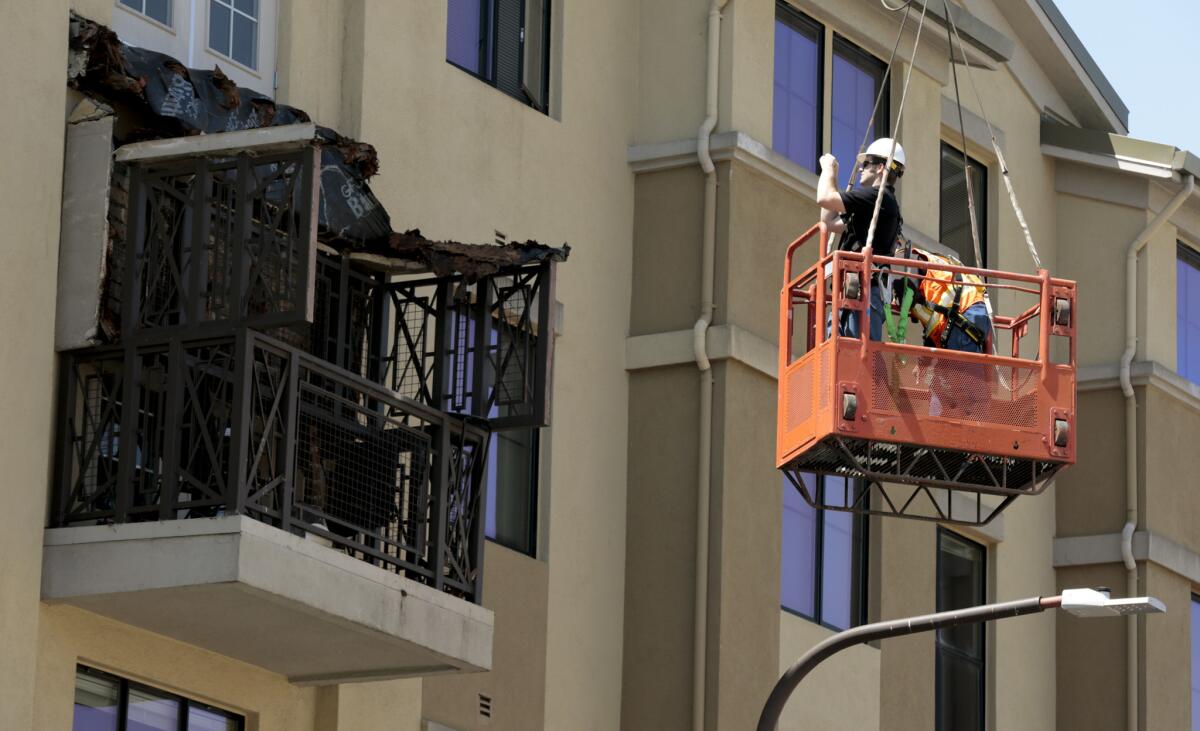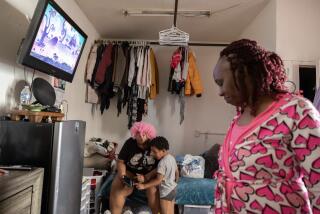Berkeley balcony collapse puts new focus on wood dry rot

Workers examine a balcony that collapsed at an apartment building in Berkeley.
- Share via
reporting from Berkeley — The wood rot that many experts believe contributed to the deadly balcony collapse here has been a problem in low-rise apartment and condominium complexes for years.
Investigators on Wednesday were trying to determine how the wood beams of the balcony that failed — killing six people — had deteriorated so thoroughly in the eight years since the apartment was built.
On Wednesday, they announced that the balcony on the floor below was also in danger of collapsing and ordered it to be removed immediately.
Outside engineers who visited the site and examined photographs said there were clear signs that the beams supporting the deck had rotted due to water exposure.
“Just eight years? I mean, that’s almost unheard of,” said Darrick Hom, president of the Structural Engineers Assn. of Northern California. “They need to figure out — I mean, literally, was there a river running through here or what?”
Wood construction of the balconies is common for low-rise residential buildings. Most often, horizontal beams, or joists, that hold up the floor inside the apartment simply extend through the exterior wall to hold up the deck.
The ubiquity of these decks makes the deadly collapse here early Tuesday that much more unnerving.
The seven beams holding up the balcony on Unit 407 of the fifth floor of the Library Gardens complex snapped in an instant, spilling 13 late-night revelers onto the ground below. Most of the victims were students visiting from Ireland, including five of the dead.
The beams should have easily held the weight of that many people, experts said.
But wood rot, also known as dry rot, can make a beam that appears sturdy porous, enough to crumble on contact, due to the growth of a fungus that feeds on the wood.
Gene St. Onge, an Oakland civil and structural engineer, visited the scene in Berkeley on Wednesday and said the water damage was clear both on the collapsed balcony and the one the below it that was ordered dismantled Wednesday.
“You can see evidence of water at the front, some staining at the front face of the lower balcony,” St. Onge said. “There’s some brown staining in the front.”
There are a variety of ways water could have leaked into the wood joists. “It could’ve been that the door above the balcony didn’t have a proper waterproof seal below it,” St. Onge said. “It could’ve been water coming in from the roof down the interior of the wall. It’s a tricky matter and it takes some investigation to determine where it came from.”
Another possibility is the lack of flashing underneath the door — a piece of angled sheet metal that diverts water draining down the stucco away from the wall.
In general, before the stucco layer is applied during construction, wood balconies can be wrapped in waterproof membranes — like sticky asphalt — and then sealed to the waterproofing of the exterior wall.
Any gaps could allow water to seep in.
Normally, there are signs of a water intrusion, said Taryn Williams, a civil and structural engineer in San Francisco, who investigates structural and waterproof failures for the company Simpson Gumertz Heger.
Cracks might appear in the stucco as well as a light-colored staining called “efflorescence.” But sometimes stucco can conceal the extent of the water damage in the interior and make a severe problem look minor on the outside.
The 177-unit apartment complex was developed by Transaction Cos., a Berkeley group, with a Richmond-based contractor, Segue Construction Inc. and TCA Architects, which has an office in Oakland.
Segue Construction, the Library Gardens’ general contractor, was targeted in two lawsuits over alleged improper waterproofing of balconies that led to wood rot, in Millbrae and San Jose.
Records show Segue paid $3 million to resolve the lawsuit in San Jose. It paid an additional $3.5 million in the Millbrae case, said Tom Miller, a lawyer who represented the residents.
Sam Singer, spokesman for Segue, said the litigation had “no bearing on this tragedy” and they involved different types of balconies.
“That litigation, that is common to major construction projects,” he said. “Segue Construction has built more than 6,000 apartment units and has never had an incident like this.”
A resident of Library Gardens, Rahila Jarrett, said the roof of her building routinely leaks water into one of her apartment bedrooms during rainy seasons. “It shorts out the light in the ceiling,” she said.
The city of Berkeley has a rental housing safety program that requires annual inspections of units, covering such issues as loose handrails, exposed wiring or water leaks.
However, the mandatory inspections do not require a review of balconies or decks. The inspections also are done by the building owner and not required to be kept on file with the city.
Tenants on their own may request an inspection of a rental unit by the city office of housing code enforcement that would include railings and decks.
The city of Berkeley released a statement saying “the building was subject to a variety of inspections under the building code until 2007, when it received its final approval. Since then, there have been inspections by Housing Code Enforcement and for any tenant improvements.”
There have been other high-profile cases of balcony failures
A second-floor balcony at a UC Santa Barbara fraternity fell during a street festival celebration in April 2013, badly injuring five students. Some sued, alleging dry rot contributed to the collapse.
The 1996 collapse of a fourth-floor balcony during a cocktail party in San Francisco left one woman dead and 14 others injured. Prosecutors said the landlord’s neglect of the building was so egregious that they brought manslaughter charges in the case, and a lawsuit resulted in $12 million in damages.
Lin and Girion reported from Los Angeles, and St. John from Berkeley. Times staff writer Javier Panzar contributed to this report from Berkeley and Joe Mozingo, Veronica Rocha and Joseph Serna from Los Angeles.
More to Read
Sign up for Essential California
The most important California stories and recommendations in your inbox every morning.
You may occasionally receive promotional content from the Los Angeles Times.













